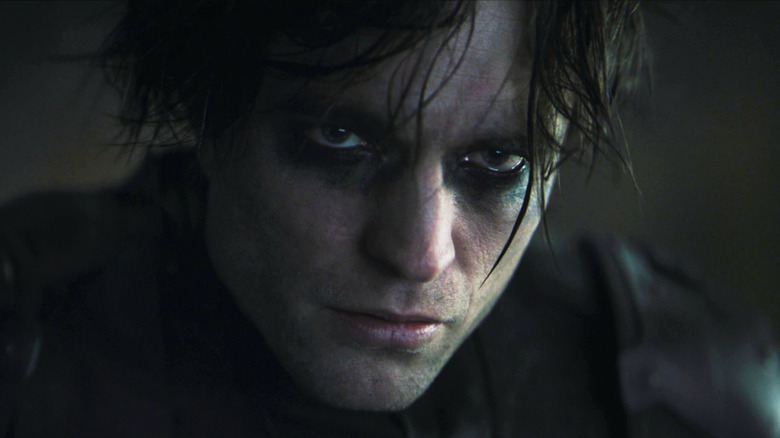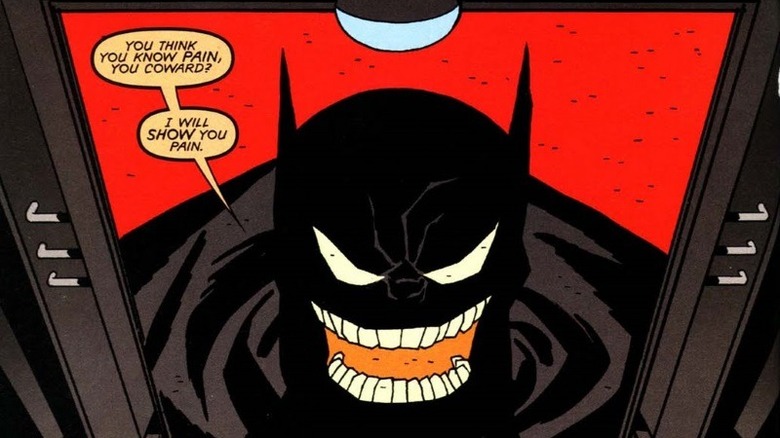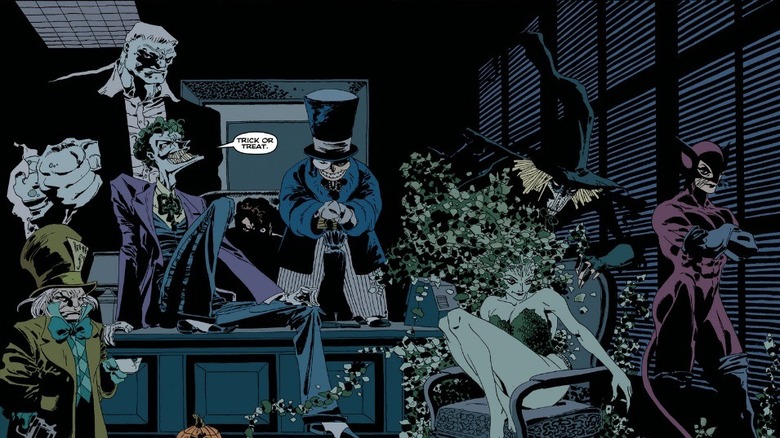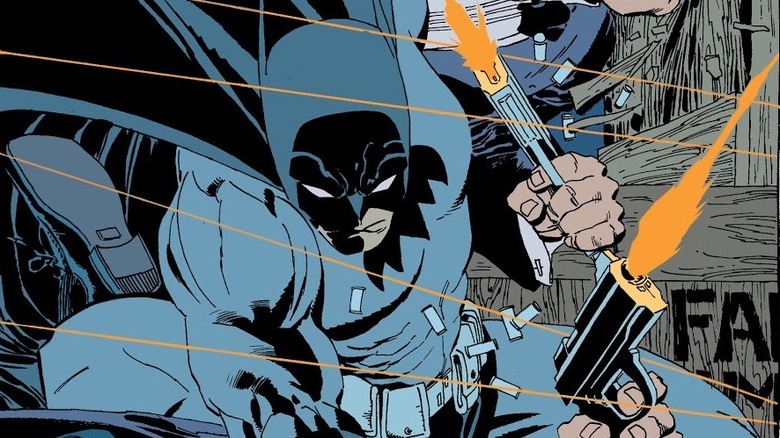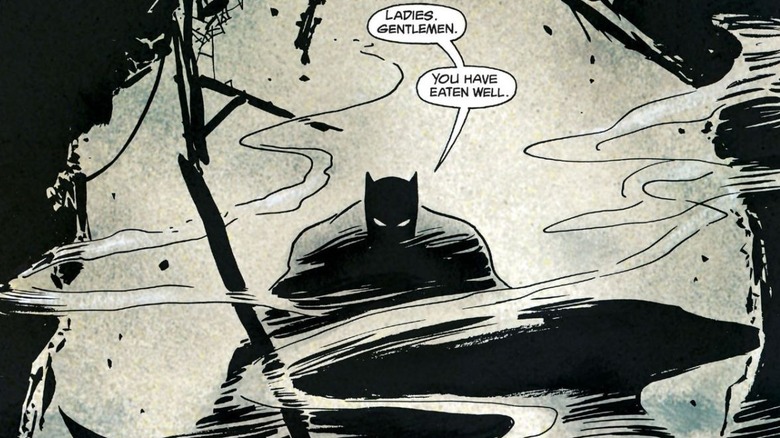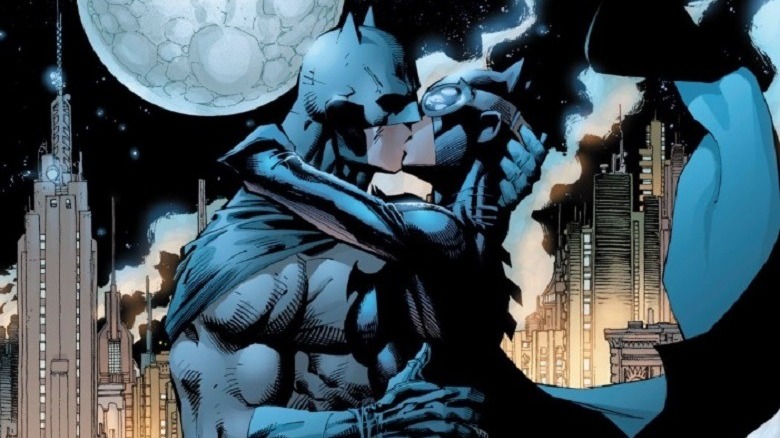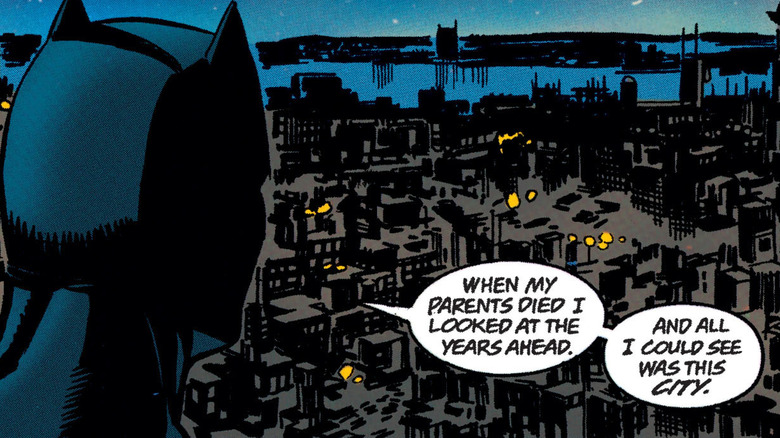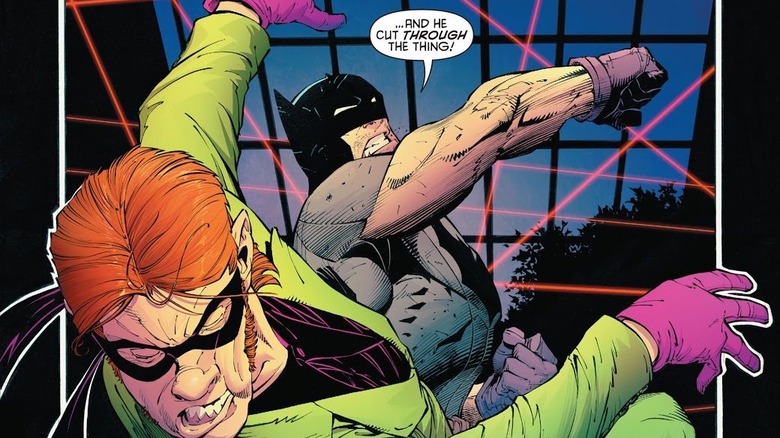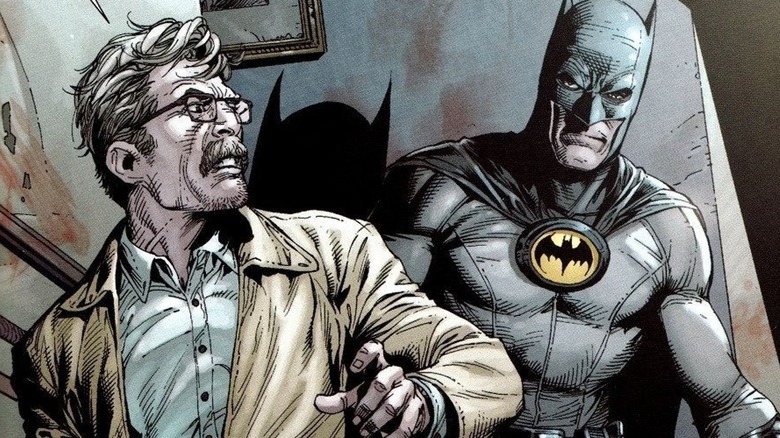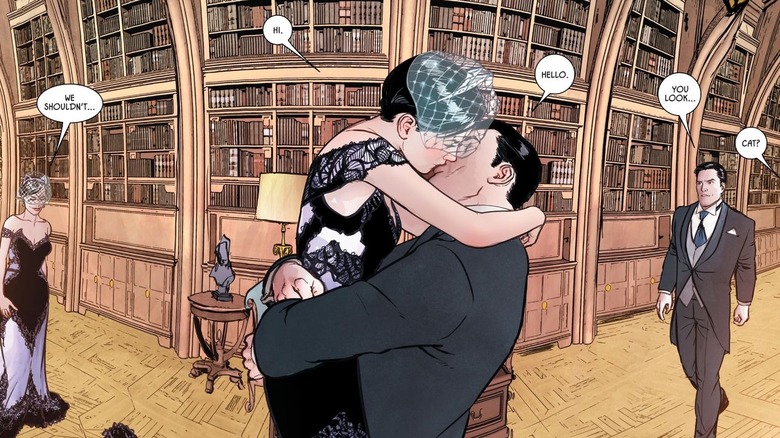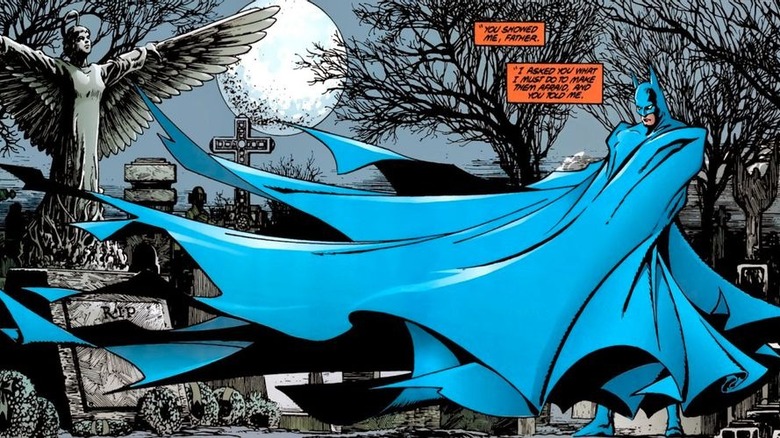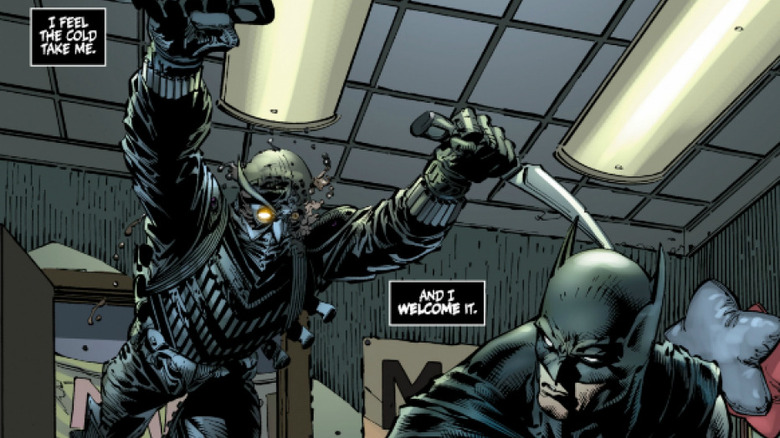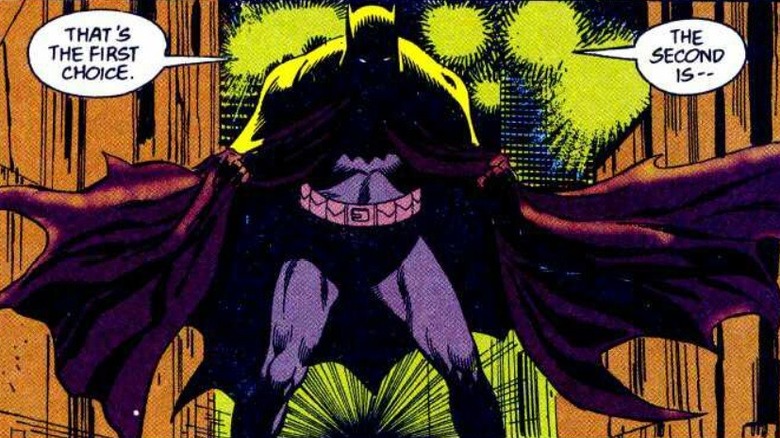All The Comic Storylines Referenced In The Batman
There's no disputing that 2022's "The Batman" is one of the most comic book-accurate films starring the titular DC hero ever made. According to many critics and fans, it's also one of the best Batman movies of all time. It just goes to show that if filmmakers respect their source material, they're likely to deliver something good.
However, comic books still don't get the respect they deserve. Superhero films rake in millions (if not billions) of dollars, inspiring oceans of fan debate regarding which cinematic versions of these cape-wearing characters are better. All the while, the comics that spawned these titanic tales are largely left on the periphery. But "The Batman" disrupts this status quo by wearing its influences proudly on its sleeve. We're here to appreciate that by exploring the sensational source material Matt Reeves, Robert Pattinson, and the rest of the movie's team drew on. These are the comic storylines referenced in "The Batman."
Ego
The whole concept of Batman is harrowing unto itself, as it essentially splits the hero into two people: Bruce Wayne and Batman. The question is, how do these two personalities co-exist as one person? Darwyn Cooke's "Batman: Ego" explores this duality by portraying Batman as Bruce Wayne's uncontrollable id. In so doing, this 2000 story showcases how the Dark Knight can be a "symbol of hope" — a line that Robert Pattinson's Batman utilizes in the film as well.
"The Batman" director Matt Reeves explained to Entertainment Weekly how "Ego" played a part in shaping his version of the Dark Knight. "I started thinking about Jekyll and Hyde and the idea of the shadow side," he said. "'Ego' really gets into this idea of the beast within him and that struggle. So, that got into the really internal, psychological struggle of being Batman." The only downside to this is that we don't get to see Pattinson arguing with Pattinson on screen, like the Evil Kermit meme. Now that would have been a magical scene to witness.
The Long Halloween
That "The Batman" starts on Halloween and is nearly three hours long are both obvious indicators that Jeph Loeb and Tim Sale's "Batman: The Long Halloween" snuck its way into the script. However, it was no big secret that the seminal '90s storyline served as major inspiration from the get-go — especially since Loeb was Matt Reeves' screenwriting teacher when he was at USC.
While the noir elements and serial killer plot thread of "The Long Halloween" are splashed all over "The Batman," it is the murkiness of Gotham City's cinematic citizens that most reminds fans of Loeb and Sale's famous tale. Throughout the film, every character makes us wonder if they have more to do with the central mystery than meets the eye — no one is entirely who they appear to be. This is a key theme of "The Long Halloween" as well. One could also argue that "The Long Halloween" is the quintessential Carmine Falcone story, as it explores his important history with Thomas Wayne. The same holds true for the mob boss in "The Batman."
Dark Victory
"Batman: Dark Victory," the 1999 sequel to "The Long Halloween," isn't as fondly remembered or revered as its predecessor. However, Jeph Loeb and Tim Sale's 14-issue series serves as the perfect follow-up, bundling several loose ends together, introducing Dick Grayson as Robin, and adding more intrigue to Selina Kyle's mysterious past. In fact, "Dark Victory" was the very first storyline to suggest she could be Carmine Falcone's illegitimate daughter.
While "The Batman" adapts the whodunit approach of "Dark Victory" and "The Long Halloween," it is perhaps more potently linked to these comics by bringing Falcone and Selina's relationship to the big screen. Ultimately, the end result is the same in both mediums: Falcone dies and Selina has to deal with the fallout of being the shady mobster's spawn. It'll be interesting to see if Falcone's eternal enemy, Sal Maroni, figures in any sequels or spin-offs that arise, or if Selina's family lineage will come back to haunt her.
Year One
In "The Batman," Gotham City is a dirty place. Grime slithers down the walls of its buildings, but the people are even filthier: They display character traits that would make Tony Soprano's goons look like upstanding, law-abiding citizens. Simply put, it feels like the film was run through a filter based on Frank Miller and David Mazzucchelli's 1987 classic, "Batman: Year One." This beloved story explores the Caped Crusader's first year on the scene as he deals with the dirty mob and the even dirtier GCPD.
In an interview with Esquire, Matt Reeves confirmed that "Batman: Year One" had a gigantic effect on "The Batman." In portraying the Batman as an inexperienced loner taking on a group of thugs and someone whose plans often border on reckless endangerment of self, this tale captures the essence of uncertainty present in every Dark Knight story. They are, after all, about a man dressed as a bat trying to reclaim his city from the criminal element. More importantly, "Batman: Year One" demonstrates how Batman wouldn't be able to do it all on his own and needs to learn how to trust others, such as Jim Gordon.
Hush
"The Batman" sees the Caped Crusader receive clues and cards from the Riddler. At one point, the vigilante wonders if his foe actually knows his real identity. Similarly, "Batman: Hush" a 2002 arc by Jeph Loeb, Jim Lee, and Scott Williams features a mysterious individual taunting Batman from afar. Eventually, it's revealed that the bandaged villain is Bruce Wayne's childhood friend Thomas Elliot, who holds a misguided grudge. That isn't the only twist in the tale, however: The Dark Knight uncovers the Riddler as the brains of the entire operation, and learns he's successfully pieced together who the man beneath the pointy-eared cowl truly is.
While "The Batman" largely contains minor threads from "Hush," there is one big Easter egg that teases the possibility of a special appearance down the line. Not only do the words "hush" flash on the screen during one of the Riddler's low-budget videos, it is also revealed that Edward Elliot was the name of the reporter who exposed Martha Wayne's history with Arkham to the world and was made to sleep with the fishes by Falcone. Perhaps his son Thomas could seek justice for his father in a sequel.
No Man's Land
In 1999, DC published a year-long storyline called "Batman: No Man's Land." It ran for over 80 issues and featured a wide range of creative teams at the wheel. The premise is simple: What would happen to Gotham City if it were hit by a massive earthquake, leaving its criminals to fend for themselves? Considering Gotham only attracts the worst of the worst, you won't be surprised to learn the answer is chaos — total chaos.
In "The Batman," it isn't an earthquake that hits the city, but a flood caused by the Riddler. While the movie doesn't show what happens to Gotham as it's left in a flooded state, it does lay the groundwork for a "No Mans Land"-ish sequel. Undoubtedly, with Gotham at its most vulnerable, criminals will see an opportunity to stake their claim on the city. That being said, these villains don't always play well together. There could be turf wars on the horizon, much like what happens in "No Man's Land." It'll be up to Batman and his hard-working friends to keep the city from being taken over by utterly ruthless forces.
Zero Year
When the Riddler debuted in 1948's "Detective Comics" #140 (via DC Comics), there was nothing scary about him. He's about as much of a threat as Bebop and Rocksteady in this issue, and perhaps even a bit less intimidating, since he actively gives away clues to catch him. In the ensuing years, the comics took an active effort to transform him from a puzzle master who's obsessed with Sudoku into a dangerous psychopath who needs to be stopped. 2013's "Batman: Zero Year" by Scott Snyder, James Tynion IV, Greg Capullo, Rafael Albuquerque, and Danny Miki redefined the Riddler for a new generation, establishing him as a menacing threat in Batman's rogues' gallery. Oh, and he also floods Gotham City.
"The Batman" borrows bits and pieces from "Zero Year," as it also presents a Riddler who wants to communicate with the world via video. At the same time, it shows us the flip side of this coin in the way the Riddler mobilizes others with his messages. The only difference between the film and "Zero Year" is that in the latter work, the Riddler takes control of Gotham after the flood — for a brief period, of course. Thankfully, Batman doesn't need to collect all of the Riddler's trophies to stop him.
Earth One
One of the defining qualities of "The Batman" is how grounded in reality it is. (Sure, it's hard to suspend disbelief that a man who wants to conceal his true identity shows off the bottom half of his face, but whatever, no one is perfect.) The film trades in the superhero theatrics for a hardboiled detective story that has more in common with "Se7en" than "Shazam." To fully convince the audience of this believability, it chooses to portray the Dark Knight as the person responsible for his costume and every one of his gadgets; he makes use of the materials around him to create his armor and vehicles.
For comic book fans, this evokes memories of Geoff Johns and Gary Frank's 2012 "Batman: Earth One" series. This take on the Caped Crusader showcases boots-on-the-ground storytelling and explores the plausibility of a rich orphan becoming a crimefighter through trial and error. Additionally, "Earth One" introduces a much tougher version of Alfred Pennyworth who teaches Bruce Wayne how to fight, and teases the Waynes' mysterious history with Arkham. Sounds familiar, doesn't it?
The Wedding
Batman and Catwoman's romance in "The Batman" is nothing new. Much like Lois Lane and Clark Kent, Selina Kyle and Bruce Wayne have been sneaking kisses (and more) on rooftops for decades now. While there are many stories that explore Batman's history with Catwoman, Tom King, Mikel Janín, and Tony S. Daniel's "The Wedding" arc reveals the reasons they might never be able to live a happy life together. Unfortunately, so long as Bruce remains committed to the Batman cause, Selina will always come second.
"The Batman" stays true to this notion, as they go their separate ways in the final scene of the film, though Selina tries to convince Bruce to leave town with her. Despite realizing that she is someone who truly means something to him, Bruce puts aside his personal happiness for the sake of his crusade. That's straight out of "The Wedding," as is Selina calling them "Bat" and "Cat" — in Tom King's run on "Batman," they almost exclusively refer to each other by these names.
Year Two
If "Batman: Year One" is Wednesday Addams, then "Batman: Year Two" is her youngest brother, Pubert. This doesn't mean the story is terrible — it's just that hardly anyone even remembers it exists. Released in 1987, "Batman: Year Two" was created by Mike W. Barr, Alan Davis, Alfredo Alcala, Todd McFarlane, and Paul Neary as a sequel to Frank Miller and David Mazzucchelli's celebrated opus. That's quite a pedigree, but the most memorable aspect of the four-issue series is probably McFarlane's Batman design: His lengthy cape looks like it could go around the world twice.
From a storytelling perspective, "The Batman" shares two similarities with "Year Two." For one, it is also set in the second year of Batman's career, which means it doesn't rehash his origin story. For two, it toys with the idea that the Dark Knight might need to cross the line to deal with Gotham City's growing criminal element. It is his strong moral code that separates him from becoming like them — but how long can that boundary stay standing?
The Court of Owls
No, the owls from "Harry Potter" didn't go rogue over at the Warner Bros. lot and flap their way to "The Batman." We're talking about the hootingly awesome 2011 "Batman: The Court of Owls" storyline by Scott Snyder and Greg Capullo, which sinks its talons into Matt Reeves' film in the most mysterious and shadowy way possible.
In the comics, the Court of Owls is introduced as an Illuminati-style outfit consisting of the wealthiest families of Gotham City, who work together to ensure they stay in control. Not only do they utilize their political influence to remain on top, they also have their own assassins, referred to as Talons, to eliminate any enemies who oppose them. "The Batman" lays the seeds for a future Court of Owls appearance as it tackles the influence of Gotham's elite. Part of the Riddler's main objective is to break the power dynamic they preside over, which has been made concrete by many generations of wealthy families — basically, the Court of Owls. Hmm ... who really is the villain in this story? Until the Court debuts in the film universe, fans are also able to find out more about this group in the "Gotham Knights" video game.
Shaman
On the surface, "Batman: Shaman" by Dennis O'Neil, John Beatty, and Ed Hannigan seems to be the total opposite of "The Batman." Kicking off in 1989, this five-issue arc follows Batman as he investigates a case bursting with rituals, human sacrifices, and a healthy dose of mysticism. This isn't the grounded take that "The Batman" offers, where the only magical component is how the Riddler managed to accumulate so many subscribers to his channel without a proper SEO strategy.
Yet the influence of "Shaman" on "The Batman" is very real, as Robert Pattinson revealed to Entertainment Weekly. He explained how it helped him understand how the Batsuit could command an almost mythical power, and why the police would allow a masked vigilante to examine a crime scene. "I thought, it's kind of [like] he's a witch doctor more than anything else," Pattinson said. "And the more you get it right, the more the police believe him, and so they start letting him into crime scenes and stuff."
